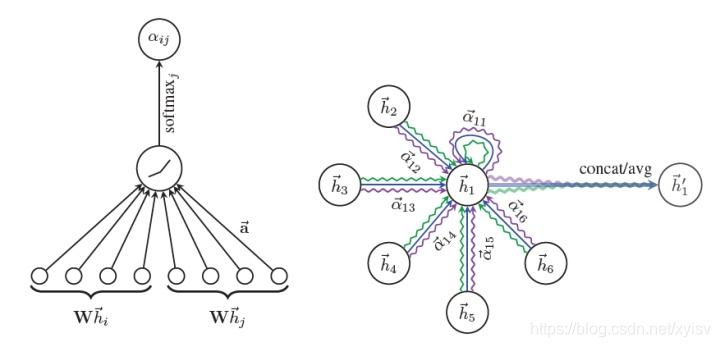论文
图注意力网络来自 Graph Attention Networks,ICLR 2018. https://arxiv.org/abs/1710.10903
注意力机制


代码
import tensorflow as tf
from tensorflow import keras
from tensorflow.python.keras import activations
from tensorflow.python.keras import constraints
from tensorflow.python.keras import initializers
from tensorflow.python.keras import regularizers
class GraphAttentionLayer(keras.layers.Layer):
def compute_output_signature(self, input_signature):
pass
def __init__(self,
input_dim,
output_dim,
adj,
nodes_num,
dropout_rate=0.0,
activation=None,
use_bias=True,
kernel_initializer='glorot_uniform',
bias_initializer='zeros',
kernel_regularizer=None,
bias_regularizer=None,
activity_regularizer=None,
kernel_constraint=None,
bias_constraint=None,
coef_dropout=0.0,
**kwargs):
"""
:param input_dim: 输入的维度
:param output_dim: 输出的维度,不等于input_dim
:param adj: 具有自环的tuple类型的邻接表[coords, values, shape], 可以采用sp.coo_matrix生成
:param nodes_num: 点数量
:param dropout_rate: 丢弃率,防过拟合,默认0.5
:param activation: 激活函数
:param use_bias: 偏移,默认True
:param kernel_initializer: 权值初始化方法
:param bias_initializer: 偏移初始化方法
:param kernel_regularizer: 权值正则化
:param bias_regularizer: 偏移正则化
:param activity_regularizer: 输出正则化
:param kernel_constraint: 权值约束
:param bias_constraint: 偏移约束
:param coef_dropout: 互相关系数丢弃,默认0.0
:param kwargs:
"""
super(GraphAttentionLayer, self).__init__()
self.activation = activations.get(activation)
self.use_bias = use_bias
self.kernel_initializer = initializers.get(kernel_initializer)
self.bias_initializer = initializers.get(bias_initializer)
self.kernel_regularizer = regularizers.get(kernel_regularizer)
self.bias_regularizer = regularizers.get(bias_regularizer)
self.kernel_constraint = constraints.get(kernel_constraint)
self.bias_constraint = constraints.get(bias_constraint)
self.input_dim = input_dim
self.output_dim = output_dim
self.support = [tf.SparseTensor(indices=adj[0][0], values=adj[0][1], dense_shape=adj[0][2])]
self.dropout_rate = dropout_rate
self.coef_drop = coef_dropout
self.nodes_num = nodes_num
self.kernel = None
self.mapping = None
self.bias = None
def build(self, input_shape):
"""
只执行一次
"""
self.kernel = self.add_weight(shape=(self.input_dim, self.output_dim),
initializer=self.kernel_initializer,
regularizer=self.kernel_regularizer,
constraint=self.kernel_constraint,
trainable=True)
if self.use_bias:
self.bias = self.add_weight(shape=(self.nodes_num, self.output_dim),
initializer=self.kernel_initializer,
regularizer=self.kernel_regularizer,
constraint=self.kernel_constraint,
trainable=True)
print('[GAT LAYER]: GAT W & b built.')
def call(self, inputs, training=True):
raw_shape = inputs.shape
inputs = tf.reshape(inputs, shape=(1, raw_shape[0], raw_shape[1]))
mapped_inputs = keras.layers.Conv1D(self.output_dim, 1, use_bias=False)(inputs)
sa_1 = keras.layers.Conv1D(1, 1)(mapped_inputs)
sa_2 = keras.layers.Conv1D(1, 1)(mapped_inputs)
con_sa_1 = tf.reshape(sa_1, shape=(raw_shape[0], 1))
con_sa_2 = tf.reshape(sa_2, shape=(raw_shape[0], 1))
con_sa_1 = tf.cast(self.support[0], dtype=tf.float32) * con_sa_1
con_sa_2 = tf.cast(self.support[0], dtype=tf.float32) * tf.transpose(con_sa_2, [1, 0])
weights = tf.sparse.add(con_sa_1, con_sa_2)
weights_act = tf.SparseTensor(indices=weights.indices,
values=tf.nn.leaky_relu(weights.values),
dense_shape=weights.dense_shape)
attention = tf.sparse.softmax(weights_act)
inputs = tf.reshape(inputs, shape=raw_shape)
if self.coef_drop > 0.0:
attention = tf.SparseTensor(indices=attention.indices,
values=tf.nn.dropout(attention.values, self.coef_dropout),
dense_shape=attention.dense_shape)
if training and self.dropout_rate > 0.0:
inputs = tf.nn.dropout(inputs, self.dropout_rate)
if not training:
print("[GAT LAYER]: GAT not training now.")
attention = tf.sparse.reshape(attention, shape=[self.nodes_num, self.nodes_num])
value = tf.matmul(inputs, self.kernel)
value = tf.sparse.sparse_dense_matmul(attention, value)
if self.use_bias:
ret = tf.add(value, self.bias)
else:
ret = tf.reshape(value, (raw_shape[0], self.output_dim))
return self.activation(ret)
参考
https://blog.csdn.net/weixin_36474809/article/details/89401552
https://github.com/PetarV-/GAT
更多内容访问 omegaxyz.com
网站所有代码采用Apache 2.0授权
网站文章采用知识共享许可协议BY-NC-SA4.0授权
© 2020 • OmegaXYZ-版权所有 转载请注明出处
本文内容由网友自发贡献,版权归原作者所有,本站不承担相应法律责任。如您发现有涉嫌抄袭侵权的内容,请联系:hwhale#tublm.com(使用前将#替换为@)